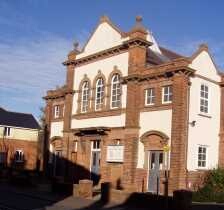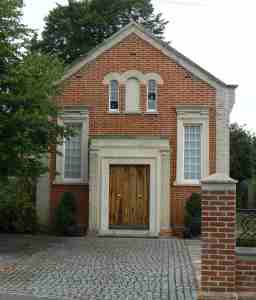The Baptist Church
From the mid
1400's some people were having doubts about religion as
taught by the Catholic Church not least because most
services were conducted in Latin which few people
understood. By the 1500's
English translations of the New Testament were being
circulated despite severe punishment by the state if
people were caught with the translations. Non conformist
prayer meeting were held in secret throughout the
County. Even with the
accession of Queen Elizabeth to the throne and the
adoption of a protestant church did not stifle
objectors, who were empowered by an understanding of the
New Testament, to enforced worship. The first Baptist
Church in the UK was founded in 1612 at Spittlefields,
London although the congregation were persecuted and
imprisoned. In the Book
Baptist Churches in Essex ( 1932) Dr W T Whitely who
carried out historical research into the Baptists
suggested " The evangelisations that began in Essex with
1639 was the origin of the Baptist Church at Burnham on
Crouch. In the following
years a number of Burnham People appeared before Quarter
Sessions for non attendance at church and refusing to
pay their church rates. In 1684 The
Church authorities accused local fisherman , John Lewis
of leading a Baptist Group that were sufficiently
organised to have a burial ground in the garden of
Thomas
Glace, a dipping pool for baptism run by William Couch
and a school run by Mary and William Diamond. In 1689 John
Couch , a Burnham man was appointed as National
Treasurer of the new Baptist Church. The members of
the church continued to grow so that by that start of
the records held by Burnham Baptist Church there were 93
members in 1691 which put pressure on meetings as
they continued to be held quietly in houses and
outbuildings By 1712 when the
climate towards nonconformists had improved and the
Baptists were able to opened a dedicated
meeting place at the Jews Well house (a now demolished
building that was immediately to the east of the Clock
tower in High Street). This building was used as a
meeting place until 1789 when
,after the death of Ham Stacey, the membership had
declined to just 4 persons which meant that the bills
were not sustainable and the Baptist returned to
meetings in their houses. In 1786 the Essex
Baptist Churches met and agreed to form an association
of Essex Baptist Churches. The Churches
involved were Braintree, Burnham on Crouch, Coggeshall,
Colchester, Earls Colne, Harlow, Langham, Potter Street,
Ridgewell, Saffron Walden, Waltham Abbey and Haverhill from Suffolk. Pastor Luke
Davies was sent to Burnham on Crouch in 1794. He immediately
carried out evangelical work with the help of the
existing four members and quickly established a large
enough group to re- open the meeting house as a Baptist
Chapel
In 1797 a 20 year
old man called John Garrington was baptised at Burnham.
He held the post of Town Schoolmaster but managed to
play a vital part in the running of the church. On two
occasions he was offered the job as Pastor of the Church
and despite initial refusals accepted the role in 1811
remaining as Pastor until 1855. During his
stewardship the Church continued to grow in size of
congregation and facilities Rev Garrington
did much to establish Evangelical Religion in Eastern
Essex as illustrated by the following story from the
Baptist Magazine of 1830 of the establishment of a
Baptist Church at Marsh Road, Tillingham. Mr Garrington the
Pastor of the Church at Burnham was returning from
London by coach in July 1816 when he became acquainted
with a Baptist friend who was going to Bradwell on
business. Their
conversation turned principally to the state of religion
in that neighbourhood. The next day
being Sabbath his friend witnessed with sorrow the total
destitution of everything like the gospel of Christ and
took the early opportunity of going to Burnham and
urging on Mr Garrington the need to introduce the gospel
there. This led Mr
Garrington to pray and ask for divine direction and
look out for a room and one was opened in Nov 1817. Here
the preaching was continued for two years by Mr Bailey
and after his removal by Mr Haynes employed by the
Essex Itinerant society. Those who were
converted were added to the church at Burnham. Mr Haynes
left and was not replaced with the responsibility for
the members returned to Mr Garrington. This
coincided with a period of illness for Mr Garrington
which meant that he was unable to spend much of his time
at Bradwell. Mr Wesley who
was a lay member who had been converted by Mr Bailey
stepped into the breach and led services. Brother
Wesley led their devotions and preached to them with
great acceptance. he has now
been engaged for about 4 years preaching five times a
week during which period between 20 and 30 people have
been called to the knowledge of the truth and the
fellowship within the church. The place
overflows with hearers and their list of Sunday School
is 180. In 1810 John
Haddon was sent to Southminster where he commenced
evangelical work to raise a congregation and succeeded
even living rent free with a church member called
Sarjeant Wilson . Baptist ministers
continued to lodge with members of the church for many
years at Southminster as no house seems to have been
provided and ministers salaries were too low to allow
them to buy or rent a house unless they had independent
means. In 1871 Rev Thomas Jones is listed in the census
as living with church member William Ely. In 1860 the
membership was high enough to raise funds and to build a
Church in North Street, Southminster. By 1829, William
Colins, The Baptist Minister at Burnham estimated his
congregation at 40 people. On Tuesday 28
September 1830 at Tillingham, Essex a Baptist Church
was formed with 35 persons. Mr George Wesley was
ordained as their pastor. Mr C R Blackett
Pastor of the Independant Baptist Church at Southminster
led the service. The annual report
for Baptist in 1835 provided some data on the churches Burnham on Crouch
- 49 members , 110 hearers and 37 children at Sunday
School Tillingham - 63
members - 450 hearers but no Sunday school members
listed Southminster was
still independent and so no data is listed. In 1861 the
Peoples History of Essex lists 28 Baptist Chapels in
Essex including Burnham and Tillingham. By 1864 the
number of churches in the Association had risen from 12
to nearly 70 but the Association was split between
factions and was dissolved. Ten Churches met
and agreed to form the Essex Baptist Union to replace
the Association. The Churches
involved were Ashdon, Braintree, Burnham on Crouch,
Colchester, Earls Colne, Halstead Head Street, Halstead
North Street, Langley, Sible Hedingham and Thaxted. The other
churches including Southminster continued to operate as
independent Baptist Churches. Burnham
established a band of hope for young people which grew
to large numbers meaning that they had to rent extra
rooms locally for bible reading classes on Sunday
afternoons and hold an additional service at 7am to fit
all the worshipers into the church. By 1904
Southminster Church led by Rev G T Ennals had joined
the Union and provided practical as well as spiritual
help to the poor by setting up a soup kitchen. In the same year
Burnham was led by Rev Charles Gooding who was so
inspirational a figure that attendance far outweighed
their facilities and the current Baptist Church was
built. Southminster
continued to grow in strength under the leadership of
Rev F R W Heath and S W Sawday up to World war One. Tragedy struck
the Congregational Church at Southminster when it was
destroyed by a German Mine. Talks between the
Baptists and Congregationalists in Southminster agreed
that they should join together to worship and both
religions used the Baptist Chapel in Burnham Road. As years went on
the congregation grew and the old chapel was sold for
use as a house and a new United Reform Church was built
in North Street, Southminster close to the spot of the
original Congregational Church.
 Burnham
Baptist Church
Burnham
Baptist Church Southminster
Old Baptist Church
Southminster
Old Baptist Church



